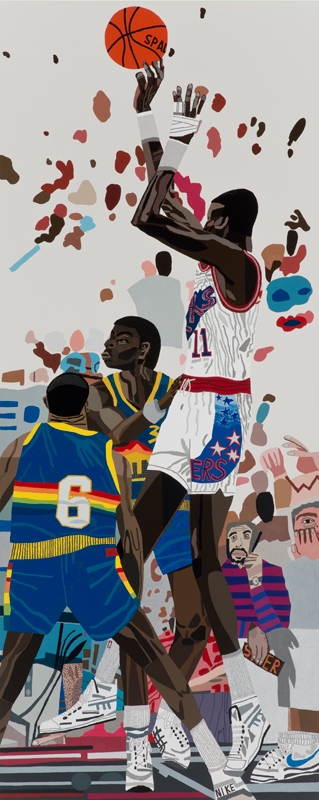The world of Jonas Wood often has a shaky but lovingly attentive feel. His paintings and drawings are calm and reflective, many showing the interiors of what look like happy lives. Wood seems genuinely to like his subject matter, to dwell nostalgically on the good memories and good people in his life.
Wood’s exhibition at David Kordansky’s new space is somewhat of a survey of his collected themes. The first of three galleries contains his plant paintings, usually featuring the ceramics of his wife, Shio Kusaka, while a second gallery features Wood’s paintings of collectable sports cards (usually baseball or basketball). The last gallery brings in the rest of Wood’s genres – landscapes, portraits, sporting events and interiors – in a salon-style hang of drawings and several large paintings.
Wood’s paintings and drawings start as photo-collages assembled from many views of the same subject. He also starts new productions from previous ones, reworking the same content into a meditation on how his life has changed or how his attitudes towards his subjects change.
For instance, Rosy in My Room (2014) pictures Wood’s father in the artist’s childhood room holding a cat (presumably a surrogate for the son who has left the nest), while Self Portrait with Momo (2014) shows Wood in the same room, holding his daughter. The simple gesture is about the passage of time, about growing up and about fatherhood, all contained in the subtle flicker between two similar but slightly different images.
In Manny Sanguillen (2009), a small gouache and coloured pencil on paper, one can see the efforts of a young boy with an urge to draw the bigger-than-life baseball players he sees on television. The boy focuses intently on the contours of the uniforms. He uses lines rather than shading to define the forms. The boy’s line is unpractised and shaky but earnest. He grinds the nubs of coloured pencils to fill shapes. He has no need to study or get precious about volumes. All told, the boy is not interested in skilfully recreating the player; instead he mimics the attention and love that he shows the baseball cards that he hoards in his room. He has looked at them so much that looking is no longer enough.
This innocent exuberance, which comes from Wood’s ability to inhabit and mimic childhood as much as reflect on it, is remarkable. It is fitting that the touchstones one most often finds associated with Wood are David Hockney and Vincent van Gogh. Wood’s spaces are built through technique and practice, the labour of a man in a world of exponentially multiplying images. But ultimately these works owe allegiance to emotion and memory. What we see is a product of how Wood feels, and his feelings are coherent and heartening, thankfully free of the temptation to manufacture drama or to exaggerate.
This article was first published in the January & February 2015 issue.
